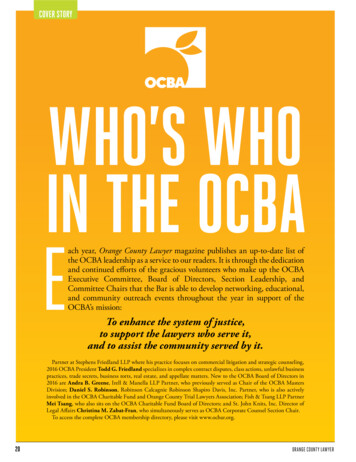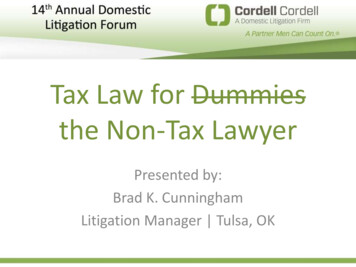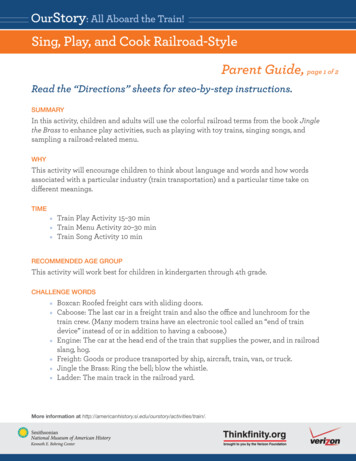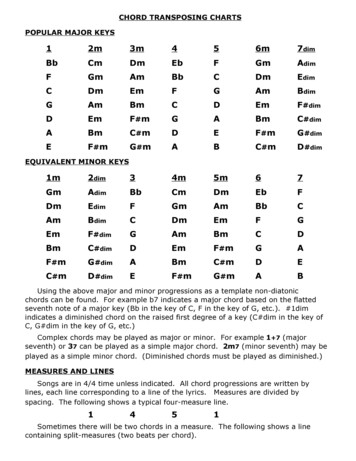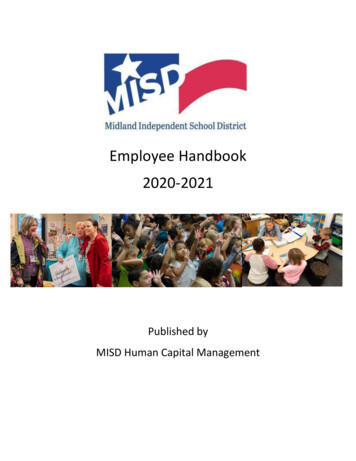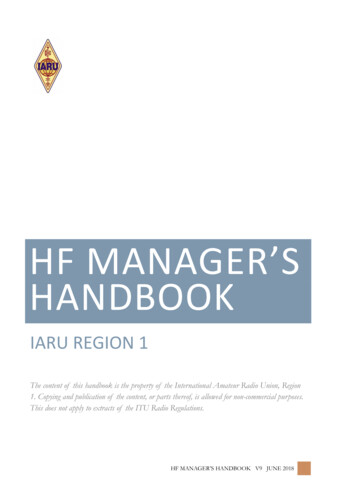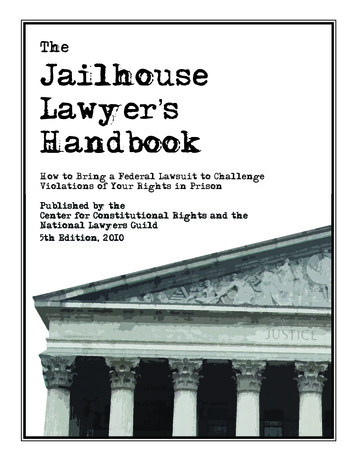
Transcription
TheJailhouseLawyer’sHandbookHow to Bring a Federal Lawsuit to ChallengeViolations of Your Rights in PrisonPublished by theCenter for Constitutional Rights and theNational Lawyers Guild5th Edition, 2010
NOTE FROM THE EDITORSThis Handbook is a resource for prisoners who wish to file a federal lawsuit addressing poor conditions in prisonor abuse by prison staff. It also contains limited general information about the American legal system. ThisHandbook is available for free to anyone: prisoners, families, friends, activists, lawyers and others.We hope that you find this Handbook helpful, and that it provides some aid in protecting your rights behindbars. Know that those of us who do this work from outside prison are humbled by the amazing work so many ofyou do to protect your rights and dignity while inside. As you work your way through a legal system that isoften frustrating and unfair, know that you are not alone in your struggle for justice.Good luck!Rachel MeeropolIan HeadThe Jailhouse Lawyers Handbook, 5th Edition. Revised in 2010. Published by:The Center for Constitutional Rights666 Broadway, 7th FloorNew York, NY 10012The National Lawyers Guild, National Office132 Nassau Street, Room 922New York, NY 10038Available on the internet at: http://jailhouselaw.orgWe would like to thank:All of the Jailhouse Lawyers who wrote in with comments, recommendations and corrections for theHandbook, all those who have requested and used the Handbook, and who have passed their copy on to othersinside prison walls. Special thanks to NLG Jailhouse Lawyer Vice President Mumia Abu-Jamal.The Sylvia Rivera Law Project for co-writing “Issues of Importance to Transgender Prisoners” in ChapterTwo, and The ACLU Reproductive Freedom Project for helpful insights regarding “Issues of Importance forWomen Prisoners.”The original writers and editors of the Handbook (formerly the NLG Jailhouse Lawyers Manual), BrianGlick, the Prison Law Collective, the Jailhouse Manual Collective and Angus Love. And special thanks toAlissa Hull and John Boston for significant work on the 2010 edition.The dozens of volunteers who have come to the NLG offices every week since 2006 to mail Handbooks toprisoners, and to Claire Dailey, Merry Neisner and all the CCR staff, interns and volunteers who put in hoursand hours of research, proofreading, cite-checking, and mailing.Jeff Fogel and Steven Rosenfeld for their work defending the Handbook in Virginia.LEGAL DISCLAIMER: This Handbook was written by CCR staff. The information included in the Handbook isnot intended as legal advice or representation, and you should not rely upon it as such. We cannot guaranteethe accuracy of this information nor can we guarantee that all the law and rules inside are current, as the lawchanges frequently.
Table of ContentsCHAPTER ONE: INTRODUCTION .1A. WHAT IS THIS HANDBOOK? . 1B. HOW TO USE THIS HANDBOOK . 1C. WHO CAN USE THIS HANDBOOK . 21.Prisoners in Every State Can Use this Handbook. 22.Prisoners in Federal Prison Can Use this Handbook. 23.Prisoners in City or County Jails Can Use this Handbook. 34.Prisoners in Private Prisons Can Use this Handbook . 3D. WHY TO TRY AND GET A LAWYER . 4E. A SHORT HISTORY OF SECTION 1983 AND THESTRUGGLE FOR PRISONERS’ RIGHTS. 5F. THE USES AND LIMITS OF LEGAL ACTION. 6CHAPTER TWO: YOUR LEGAL OPTIONS .7A. SECTION 1983 LAWSUITS . 71.Violations of Your Federal Rights. 72.“Under Color of State Law” . 8B. STATE COURT CASES . 9C. FEDERAL TORTS CLAIMS ACT (FTCA) . 91.Who You Can Sue. 102.Types of Torts . 11a. NEGLIGENCE . 11b. INTENTIONAL TORTS . 11c. FALSE IMPRISONMENT . 11d. INTENTIONAL INFLICTION OF EMOTIONAL DISTRESS . 123.Administrative Exhaustion . 124.Damages in FTCA Suits . 125.The Discretionary Function Exception . 12D. BIVENS ACTIONS AND FEDERAL INJUNCTIONS . 131.Who is Acting Under Color of Federal Law? . 132.Unconstitutional Acts by Federal Officials . 143.Federal Injunctions . 14E. PROTECTION OF PRISONERS UNDER INTERNATIONAL LAW . 14F. BRIEF SUMMARY OF THE PRISONLITIGATION REFORM ACT (PLRA) . 151.Injunctive Relief. 152.Exhaustion of Administrative Remedies . 153.Mental Emotional Injury . 164.Attorneys’ Fees. 165.Screening, Dismissal and Waiver of Reply. 166.Filing Fees and the Three Strikes Provision . 16CHAPTER THREE: YOUR RIGHTS IN PRISON.17A. YOUR FIRST AMENDMENT RIGHT TO FREEDOM OFSPEECH AND ASSOCIATION, AND THE TURNER TEST. 171.Access to Reading Materials . 182.Free Expressions of Political Beliefs . 203.Limits on Censorship of Mail . 21a. OUTGOING MAIL . 21b. INCOMING MAIL . 21c. LEGAL MAIL. 224.Access to the Telephone . 22
5.Your Right to Receive Visits from Family and Friendsand to Maintain Relationships in Prison . 23a. ACCESS TO VISITS . 23b. VISITATION FOR LESBIAN, GAY, BISEXUAL ANDTRANSGENDER PRISONERS . 24c. RELATIONSHIPS WITH OTHER PRISONERS . 25d. CARING FOR YOUR CHILD IN PRISON . 25B. YOUR RIGHT TO PRACTICE YOUR RELIGION . 261.Free Exercise Clause. 262.Establishment Clause . 273.Fourteenth Amendment Protection of Religion. 274.Religious Freedom Restoration Act (RFRA) and Religious LandUse and Institutionalized Persons Act (RLUIPA). 285.Cases and Issues. 28C. YOUR RIGHT TO BE FREE FROM DISCRIMINATION . 291.Freedom from Racial Discrimination . 302.Freedom from Gender Discrimination. 31a. THE “SIMILARLY SITUATED” ARGUMENT . 32b. THE EQUAL PROTECTION TEST FOR GENDER DISCRIMINATION . 323.Freedom from Other Forms of Discrimination . 33D. YOUR PROCEDURAL DUE PROCESS RIGHTSREGARDING PUNISHMENT . 331.Two Important Supreme Court CasesGovern Due Process Rights for Prisoners. 332.Transfers and Segregation . 34E. YOUR RIGHT TO BE FREE FROM UNREASONABLESEARCHES AND SEIZURES. 35F. YOUR RIGHT TO BE FREE FROM CRUEL ANDUNUSUAL PUNISHMENT. 361.Protection from Physical Brutality. 362.Rape, Sexual Assault and Sexual Harassment . 37a. OUTRAGEOUS CONDUCT VS. UNCONSTITUTIONAL CONDUCT . 38b. PSYCHOLOGICAL HARM . 38c. CONSENSUAL SEX BETWEEN PRISONERS AND GUARDS . 39d. CHALLENGING PRISON SUPERVISORS AND PRISON POLICIES. 393.Your Right to Decent Conditions in Prison. 394.Your Right to Medical Care . 41a. SERIOUS MEDICAL NEED. 42b. DELIBERATE INDIFFERENCE . 42c. CAUSATION . 43G. YOUR RIGHT TO USE THE COURTS. 431.The Right to File Papers and Meet withLawyers and Legal Workers . 442.Access to a Law Library. 453.Getting Help from a Jailhouse Lawyer andProviding Help to Other Prisoners. 454.Dealing with Retaliation . 46H. ISSUES OF IMPORTANCE TO WOMEN PRISONERS. 471.Medical Care. 47a. PROPER CARE FOR WOMEN PRISONERS . 48b. MEDICAL NEEDS OF PREGNANT WOMEN . 482.Your Right to an Abortion in Prison . 49a. FOURTEENTH AMENDMENT CLAIM . 49b. EIGHT AMENDMENT CLAIM. 503.Observations and Searches by Male Guards . 51
I.ISSUES OF IMPORTANCE TO TRANSGENDER PRISONERS . 521.Classification. 52a. PLACEMENT IN MALE OR FEMALE FACILITIES . 52b. INVOLUNTARY SEGREGATION . 53c. ACCESS TO PROTECTIVE CUSTODY. 542.Health . 55a. ACCESS TO GENDER-AFFIRMING HEALTH CARE . 55b. CONFIDENTIALITY . 573.Free Gender Expression. 57a. CLOTHING AND GROOMING . 57b. NAME AND ID GENDER CHANGES . 59c. ACCESS TO READING MATERIAL . 60d. JOB/PROGRAM DISCRIMINATION . 604.Dealing with Violence and Abuse . 61a. VERBAL HARASSMENT . 61b. RAPE AND SEXUAL ASSAULT . 61c. STRIP SEARCHES. 62J. ISSUES OF IMPORTANCE TO PRETRIAL DETAINEES. 62K. ISSUES OF IMPORTANCE TO NON-CITIZENSAND IMMIGRATION DETAINEES . 64CHAPTER FOUR: STRUCTURING YOUR LAWSUIT .67A. WHAT TO ASK FOR IN YOUR LAWSUIT . 67B. INJUNCTIONS . 681.Preliminary Injunctions and Permanent Injunctions . 682.Exhaustion and Injunctions . 693.Temporary Restraining Orders . 69C. MONEY DAMAGES . 691.The Three Types of Money Damages . 692.Damages Under the PLRA . 703.Deciding How Much Money to Ask For . 71D. WHO YOU CAN SUE . 711.Who to Sue for an Injunction. 722.Who to Sue for Money Damages:the Problem of “Qualified Immunity” . 733.What Happens to Your Money Damages. 74E. SETTLEMENTS . 74F. CLASS ACTIONS. 74CHAPTER FIVE: HOW TO START YOUR LAWSUIT .76A. WHEN TO FILE YOUR LAWSUIT . 761.Statute of Limitations. 772.Exhaustion of Administrative Remedies . 77B. WHERE TO FILE YOUR LAWSUIT . 78C. HOW TO START YOUR LAWSUIT. 781.Summons and Complaint. 79a. COMPLAINT . 79b. SUMMONS. 842.In Forma Pauperis Papers . 843.Request for Appointment of Counsel . 874.Declarations . 88D. HOW TO SERVE YOUR LEGAL PAPERS . 89E. GETTING IMMEDIATE HELP FROM THE COURT. 90F. SIGNING YOUR PAPERS . 91
CHAPTER 6: WHAT HAPPENS AFTER YOU FILE SUIT .92A. SHORT SUMMARY OF A LAWSUIT. 92B. DISMISSAL BY THE COURT AND WAIVER OF REPLY . 93C. HOW TO RESPOND TO A MOTION TODISMISS YOUR COMPLAINT . 94D. THE PROBLEM OF MOOTNESS . 95E. DISCOVERY. 961. Discovery Tools . 972. What You Can See and Ask About . 993. Privilege. 994. Some Basic Steps . 995. Some Practical Considerations. 1006. Procedure. 1007. Their Discovery of Your Information and Material. 101F. SUMMARY JUDGMENT . 1011. The Legal Standard. 1012. Summary Judgment Procedure . 1033. Summary Judgment in Your Favor . 103G. WHAT TO DO IF YOUR COMPLAINT IS DISMISSEDOR THE COURT GRANTS DEFENDANTSSUMMARY JUDGMENT . 1031. Motion to Alter or Amend the Judgment. 1042. How to Appeal the Decision of the District Court . 104CHAPTER 7: THE LEGAL SYSTEM AND LEGAL RESEARCH.105A. THE IMPORTANCE OF PRECEDENT. 1051. The Federal Court System . 1052. How Judges Interpret Laws on the Basis of Precedent . 1053. Statutes. 1074. Other Grounds for Court Decisions . 107B. LEGAL CITATIONS – HOW TO FIND COURTDECISIONS AND OTHER LEGAL MATERIAL . 1071. Court Decisions . 1072. Legislation and Court Rules . 1103. Books and Articles . 1104. Research Aids . 111C. LEGAL WRITING . 111APPENDICESAppendix A: Glossary of Terms . 113Appendix B: Sample Complaint . 119Appendix C: FTCA Form . 123Appendix D: More Legal Forms and Information. 125Appendix E: Constitutional Amendments . 126Appendix F: Excerpts from the PLRA . 128Appendix G: Universal Declaration of Human Rights. 131Appendix H: Sources of Legal Support . 134Appendix I: Sources of Publicity . 135Appendix J: Prisoners’ Rights Books and Newsletters. 136Appendix K: Free Book Programs . 137Appendix L: District Court Addresses . 138
CHAPTER ONE: INTRODUCTIONSECTION AWhat Is This Handbook?This Handbook explains how a prisoner can start alawsuit in federal court, to fight against mistreatmentand bad conditions in prison. Because most prisonersare in state prisons, we focus on those. However,people in federal prisons and city or county jails will beable to use the Handbook too.We, the authors of the Handbook, do not assume that alawsuit is the only way to challenge abuse in prison orthat it is always the best way. We believe that a lawsuitcan sometimes be one useful weapon in the struggle tochange prisons and the society that makes prisons theway they are.The Handbook discusses only some of the legalproblems which prisoners face – conditions insideprison and the way you are treated by prison staff.The Handbook does not deal with how you got toprison or how you can get out of prison. It does notexplain how to conduct a legal defense against criminalcharges or a defense against disciplinary measures forsomething you supposedly did in prison.Chapter One: Table of ContentsHandbook is mostly about only one kind of legalaction: a lawsuit in federal court based on federal law.For prisoners in State prison, this type of lawsuit isknown as a “Section 1983” suit. It takes its name fromSection 1983 of Title 42 of the United States Code. TheU.S. Congress passed Section 1983 to allow people tosue in federal court when a state or local officialviolates their federal rights. If you are in state prison,you can bring a Section 1983 suit to challenge certaintypes of poor treatment. Chapter Three of thisHandbook explains in detail which kinds of problemsyou can sue for using Section 1983.SECTION BHow To Use This HandbookThe Handbook is organized into six chapters andseveral appendices. This is Chapter One, which gives you anintroduction to the Handbook. Sections C throughE of this chapter indicate the limits of thisHandbook and explain how to try to get a lawyer.Sections F and G give a short history of Section1983 and discuss its use and limits in politicalstruggles in and outside prison Chapter Two discusses the different types oflawsuits available to prisoners and summarizes animportant federal law that limits prisoners’ accessto the courts, called the “Prison Litigation ReformAct.” Chapter Three summarizes many of yourConstitutional rights in prison. Chapter Four explains how to structure yourlawsuit, including what kind of relief you can suefor, and who to sue. Chapter Five gives the basic instructions forstarting a federal lawsuit and getting immediatehelp from the court – what legal papers to file,when, where and how. It also provides templatesand examples of important legal documents. Chapter Six discusses the first things that willhappen after you start your suit. It helps yourespond to a “motion to dismiss” your suit or aSection A:What is this Handbook?Section B:How to Use this HandbookSection C:Who Can Use this HandbookSection D:Why to Try and Get a LawyerSection E:A Short History of Section 1983 and the Struggle forPrisoner's RightsSection F:The Uses and Limits of Legal ActionThe Importance of “Section 1983”A prisoner can file several different kinds of casesabout conditions and treatment in prison. ThisJAILHOUSE LAWYER’S HANDBOOK – CHAPTER ONE1
“motion for summary judgment” against you. Italso tells you what to do if prison officials winthese motions. It explains how to use “pre-trialdiscovery” to get information and materials fromprison officials.example, a federal court in New York may come to oneconclusion about an issue, while a federal court inTennessee may reach a totally different conclusionabout the same issue.Chapter Seven gives some basic information aboutthe U.S. legal system. It also explains how to findlaws and court decisions in a law library and howto refer to them in legal papers.First Steps:The Appendices are additional parts of theHandbook that provide extra information. Theappendices to the Handbook provide materials foryou to use when you prepare your suit and afteryou file it. Appendix A contains a glossary of legalterms. Appendix B a sample complaint in a prisoncase. Appendices C and D contain forms for basiclegal papers. You will also find helpful forms andsample papers within Chapters Four and Five.Appendix E gives the text of the first FifteenAmendments to the U.S. Constitution. Appendix Fhas a few of the important sections of the PrisonLitigation Reform Act, and Appendix G includesthe Universal Declaration of Human Rights.Appendices H and I list possible sources ofsupport and publicity – legal groups, political andcivic groups that help prisoners, progressivemagazines and newspapers that cover prison issues,and other outlets you can write to. Appendix J listsother legal materials you can read to keep up todate and learn details which are not included in thismanual. Appendix K lists free book programs forprisoners, and Appendix L includes a list ofaddresses of Federal District Courts for yourreference.We strongly recommend that you read the wholehandbook before you start trying to file your case.1. Know Your Rights! Ask yourself: have my federalrights been violated? If you have experienced one ofthe following, the answer may be yes: Guard or prisoner brutality or harassmentUnsafe cell or prison conditionsCensorship, or extremely limited mail, phone, orvisit privilegesInadequate medical careInterference with practicing your religionInadequate foodRacial, sexual or ethnic discriminationPlacement in the hole without a hearing2. Exhaust the Prison Grievance System! Use all thesteps in the prison complaint or grievance system andwrite up your concerns in detail. Appeal it all the wayand save your paperwork. You MUST do this beforefiling a suit.3. Try to Get Help! Consider trying to hire a lawyer ortalking to a jailhouse lawyer, and be sure to request apro se Section 1983 packet from your prison law libraryor the district court.States also have their own laws, and their ownconstitutions. State courts, rather than federal courts,have the last word on what the state constitution means.This means that in some cases, you might have moresuccess in state court than in federal court. You canread more about this possibility in the next chapter.Most of the prisoners in the Country are in State prison,but prisoners in other sorts of prisons or detentioncenters can use this book too.Unfortunately, we don’t have the time or the space totell you about the differences in the law from state tostate. So while using this Handbook, you should alsotry to check state law using the resources listed inAppendix J. You can also check the books available inyour prison and contact the nearest office of theNational Lawyers Guild or any other lawyers, lawstudents or political groups you know of that supportprisoners’ struggles.1. Prisoners in Every State Can Use ThisHandbook2. Prisoners in Federal Prison Can UseThis HandbookSection 1983 provides a way for State Prisoners toassert their rights under the United States Constitution.Every State Prisoner in the country, no matter whatstate he or she is in, has the same rights. However,different courts interpret these rights differently. ForIf you are in federal prison, this Handbook will also behelpful. Federal prisoners have basically the samefederal rights as state prisoners. Where things aredifferent for people in federal prison, we have tried tomake a note of it for you.SECTION CWho Can Use This HandbookJAILHOUSE LAWYER’S HANDBOOK – CHAPTER ONE2
The major difference is that federal prisoners cannotuse Section 1983 to sue about bad conditions andmistreatment in federal prison. Instead, you have acouple options. You can use a case called Bivens v. SixNamed Agents of Federal Bureau of Narcotics, 403U.S. 388 (1971). In Bivens, the Supreme Court said thatyou can sue in federal court whenever a federal officialviolates your rights under the U.S. Constitution. This iscalled a “Bivens action.”Federal prisoners can also use a federal law called the“Federal Tort Claims Act” (FTCA) to sue the UnitedStates directly for your mistreatment. Both Bivens andFTCA suits are explained in more detail in ChapterTwo. The bottom line is that federal and state prisonershave mostly the same rights, but they will need to useslightly different procedures when filing a case.3. Prisoners in City or County Jails canuse this HandbookPeople serving sentences in jail have the same rightsunder Section 1983 and the U.S. Constitution as peoplein prison. Usually, these are city jails but can be anykind of jail run by a municipality. A “municipality” is acity, town, county or other kind of local government.People in jail waiting for trial are called “pretrialdetainees,” and sometimes have more protection underthe Constitution than convicted prisoners. ChapterThree, Section J discusses some of the ways in whichpretrial detainees are treated differently than convictedprisoners. However, you can still use most of the casesand procedures in this Handbook to bring your Section1983 claim. Where things are different for people injails, we have tried to make not
NOTE FROM THE EDITORS This Handbook is a resource for prisoners who wish to file a federal lawsuit addressing poor conditions in prison or abuse by prison staff. It also contains lim


